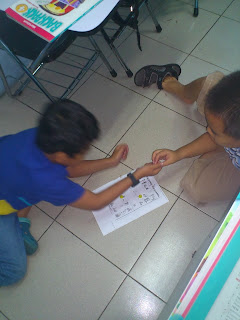It’s been difficult to teach children with some fun
sometimes. As for me, it is not that easy to create games by myself related to
the topic discussed in the book. But this time, the material gave me some rooms
to be a bit creative to create some games. The topic is about hobby with
comparative and superlative as the grammar focus.
There are some activities to expose students to the grammar
and the topic. You can find them all as follow:
1.
Tic Tac toe
This is a common game that almost all teachers know how to
play it. But this time, the words inside the boxes are adjectives with one
syllable since this is the first encounter of comparative and superlative.
cute
|
hard
|
close
|
tall
|
high
|
good
|
bad
|
late
|
cheap
|
Divide the students into 2 groups. Give each of them marker.
Play rock, paper, scissors to decide who will start the game. They take turn to
fill in the box. The winner is the group who can make correct answers in three
boxes diagonally or vertically.
2.
Domino
Make this domino adjusted as the topic: hobby. I happened to
make it myself. It’s like the common domino but this time the dots replaced by
words and pictures. In one piece of card, there will be one activity and one
picture showing an activity/ hobby.
How to play this domino is similar to common domino. Place one
card on the floor. One student starts to play by placing his card next to one
on the floor and say the sentence: I think playing football is harder than
reading a book. The next student takes turn by doing the same thing. It goes on
until they run out the cards.
3.
Board Game
This board game is available in www.toolsforeducators.com .
You can make it by yourself with Hobby. Just click the pictures you want to put
in the board game and click Make It.
How to play the game is almost similar to the common board
game. You need to provide dice and pointers. You can have three or four
students in one group. First player rolls the die and put the pointer. He makes
a sentence without putting any comparative. The next player will roll the die
and put the pointer, then a sentence describing a comparison. For example: I
think playing marble is better than playing cards. The third player will roll
the die, put the pointer then a sentence. This time he compares the last
activity from the second student. For example: I think playing card easier than
knitting.
4.
Playing cards
Some kids like playing cards. This time, they make the cards
on their own. The book introduces comparison among singers, sports celebrities
and actors. They list down their favorite actors, singers and sports celebrities
in different pieces of paper. The teacher collects all the cards for all
students then scrambles them.
How to play the cards is simple. One student puts a card on
the floor. It says Rihanna. She can make a sentence: Rihanna is a good singer. The
second student puts the card she has, it says: Rowan Atkinson is funnier than
Rihanna. The third and the rest of the students will do the same until they
finish their cards.
Note:
First, don’t forget to drill the students with the
expressions of giving opinion and grammar. It is suggested to introduce them to
some other easier vocabulary so that they won’t repeat the same words, related
to hobby. Teachers can help them with some names of singers, actors and sports
celebrities in order to avoid using the same name more than three times.
Tags:
sharing program








